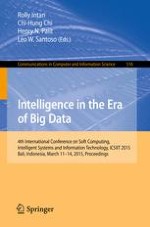This book constitutes the refereed proceedings of the 4th International Conference on Soft Computing, Intelligent Systems, and Information Technology, ICSIIT 2015, held in Bali, Indonesia, in March 2015. The 34 revised full papers presented together with 19 short papers, one keynote and 2 invited talks were carefully reviewed and selected from 92 submissions. The papers cover a wide range of topics related to intelligence in the era of Big Data, such as fuzzy logic and control system; genetic algorithm and heuristic approaches; artificial intelligence and machine learning; similarity-based models; classification and clustering techniques; intelligent data processing; feature extraction; image recognition; visualization techniques; intelligent network; cloud and parallel computing; strategic planning; intelligent applications; and intelligent systems for enterprise, government and society.
